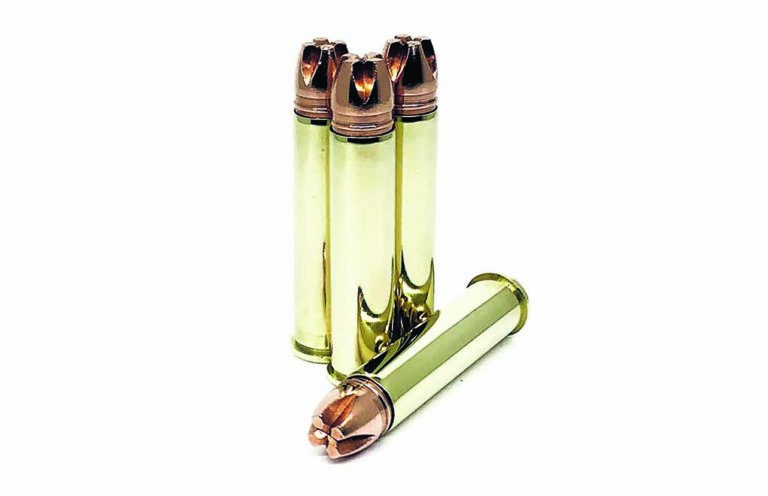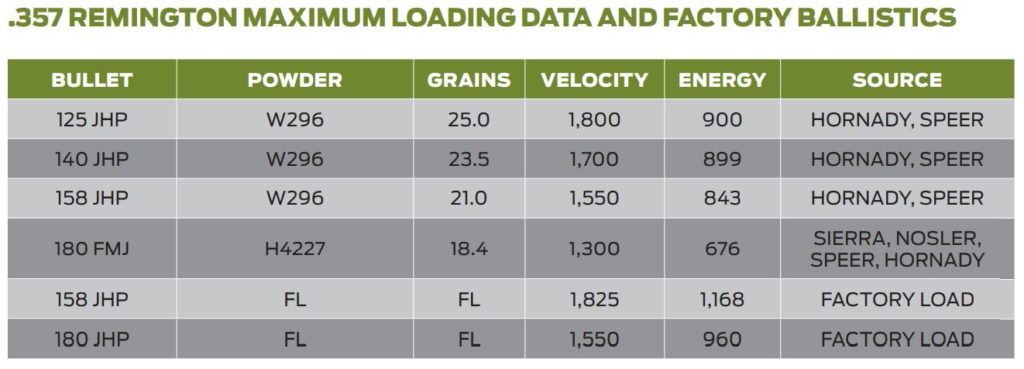
The nearly forgotten, ultra-fast, ultra-flat revolver round, the .357 Remington Maximum pushed the boundaries.
How Does The Hot-Rod .357 Remington Maximum Stack Up:
- This cartridge is a .310-inch elongation of the .357 Magnum.
- It's capable of pushing a 125-grain bullet up to 1,800 fps at the muzzle.
- Revolvers chambered for it tended to develop excessive gas-cutting on the top strap.
Historical Notes
The .357 Remington Maximum was announced as a joint venture between Remington Arms Co. and Sturm, Ruger and Co. This cartridge is a .310-inch elongation of the .357 Magnum case.
The first handgun to chamber the round was the Ruger Blackhawk .357 Maximum single-action revolver, introduced in 1983. This was followed, in 1984, by the Dan Wesson double-action revolver, the Seville single-action, stainless steel revolver and finally, the Thompson/Center Contender single-shot pistol. During the same year, Harrington & Richardson chambered its Model 258 single-shot rifle for the round, as did Savage in its Model 24V and Model 24VS Camper over/under rifle-shotgun combination guns. Although Remington developed the commercial .357 Maximum, a similar wildcat cartridge was actually developed by Elgin Gates at an earlier time.
Unfortunately, the .357 Remington Maximum revolvers all developed excessive gas-cutting on the top strap just forward of the cylinder within 1,000 rounds or so when fired with full factory loads. Ruger withdrew its Blackhawk .357 Maximum revolver from production, pending additional research and possible engineering changes. When Dan Wesson revolvers were still in production prior to the company’s purchase by CZ, it eliminated the problem by establishing a .002-inch barrel/cylinder gap for its .357 Maximum revolvers (the Dan Wesson revolvers have interchangeable barrels that are easily replaced and fine-tuned by the customer using a furnished gap tool). Top strap erosion, of course, isn’t a problem with the single-shot Thompson/Center Contender or the rifles chambering the .357 Maximum.
Check Out Our: Reloading Data Center
Our Top Articles on .357 Magnum Revolvers & Ammo
- Choosing the Best .357 Revolver for Your Needs
- Pros and Cons Explored: Is .357 Magnum Good for Self-Defense?
- Exploring Pistol-Caliber Rifles – Is .357 Magnum the Best Option?
- Top Features of a .357 Snub Nose Pistol for Self-Defense
General Comments
Efforts to develop ultra-high-velocity revolvers haven’t been crowned with unbridled success. The .22 Remington Jet in the Model 53 Smith & Wesson revolver is another example of a combination that was discontinued because of mechanical troubles. In the case of the .357 Maximum, the cartridge differs from the standard .357 Magnum only in case length, so one can drop back to shooting the .357 Magnum in any Maximum revolver or simply handload to lower-velocity levels using the Maximum case.
Factory ballistics were taken in a 10.5-inch, vented test barrel, and actual muzzle velocity from a revolver with the same-length barrel is about 200 fps slower than the advertised figure.
The .357 Remington Maximum was conceived primarily as an ultra-velocity, flat-trajectory silhouette cartridge. That it would also make a good field cartridge for hunting small and medium game is obvious. Many would consider it a good deer cartridge, but when used in a handgun, it would be rather marginal for that purpose. Of course, a good deal depends on the skill of the person using it and, as noted elsewhere, the older, less-powerful .357 Magnum has killed its share of big game. Certainly, the .357 Maximum has been used as a big-game handgun cartridge, but the measure of success has reflected more upon the person behind the gun than the cartridge.

Editor's Note: This article is an excerpt from Cartridges of the World, 16th Edition.
Raise Your Ammo IQ:
- Beyond The 6.5 Creedmoor: The Other 6.5 Cartridges
- The Lonesome Story Of The Long-Lost 8mm
- Why The .300 H&H Magnum Still Endures
- .350 Legend Vs .450 Bushmaster: Does One Win Out For Hunting?

Next Step: Get your FREE Printable Target Pack
Enhance your shooting precision with our 62 MOA Targets, perfect for rifles and handguns. Crafted in collaboration with Storm Tactical for accuracy and versatility.
Subscribe to the Gun Digest email newsletter and get your downloadable target pack sent straight to your inbox. Stay updated with the latest firearms info in the industry.

![Best Concealed Carry Guns In 2025 [Field Tested] Wilson Combat EDC X9S 1](https://gundigest.com/wp-content/uploads/Wilson-Combat-EDC-X9S-1-324x160.jpg)


![Best 9mm Carbine: Affordable PCCs [Tested] Ruger Carbine Shooting](https://gundigest.com/wp-content/uploads/Ruger-Carbine-Shooting-100x70.jpg)
![Best AR-15: Top Options Available Today [Field Tested] Harrington and Richardson PSA XM177E2 feature](https://gundigest.com/wp-content/uploads/Harrington-and-Richardson-PSA-XM177E2-feature-100x70.jpg)

Has anyone ever been able to substantiate the claim that Elgin Gates created any such thing? I’d love to see the evidence. Based on no evidence whatsoever, I can only extend to him the benefit of a doubt that he may have once had a passing thought regarding an elongated 357 prior to Ruger establishing this new round. Authors repeating what they’d read for enough generations will eventually make it “true,” but there is still no evidence. I believe the next author who repeats this unsubstantiated claim owes their audience some actual research to discover an actual cartridge case, at least a drawing, test data, notes, a sketch – not hearsay based solely on Mr. Gates’ word. I’m pretty much a “nobody,” and I’ve had numerous ideas upon which I never acted, only to eventually see someone else bring the same or a similar idea into reality. I’m not whining about how someone stole my idea, because I have no rightful claim to it. That’s how things work. Otherwise – nice article about one of my favorite cartridges.